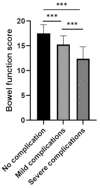The association between short-term postoperative complications and bowel function after surgery for Hirschsprung disease
- PMID: 40604482
- PMCID: PMC12220095
- DOI: 10.1186/s12887-025-05861-9
The association between short-term postoperative complications and bowel function after surgery for Hirschsprung disease
Abstract
Objective: This study aims to investigate the relationship between postoperative short-term complications and bowel function in patients with Hirschsprung disease (HSCR), and to explore the risk factors affecting bowel function.
Methods: The medical records of 367 eligible patients diagnosed with HSCR were reviewed. According to the bowel function score (BFS), patients were divided into a normal bowel function group (200 cases, BFS > 17) and an abnormal bowel function group (167 cases, BFS ≤ 17), and the possible risk factors for poor bowel function were evaluated through univariate and multivariate analysis. According to the Clavien Madadi (CM) classification of complications, CM grades I and II were considered mild complications and CM III and IV were considered severe complications.
Results: According to binary logistic regression analysis, long-segment disease (OR = 3.255; 95% CI, 1.192-9.655; p = 0.026), formula feeding (OR = 3.081; 95% CI, 1.626-5.933; p = 0.001), mild complications (OR = 9.560; 95% CI, 4.261-24.01; p < 0.001), and severe complications (OR = 17.127; 95% CI, 4.280-116.6; p < 0.001) were independent risk factors for postoperative poor bowel function. The surgery age between 1 and 3 years (OR = 0.357; 95% CI, 0.158-0.791; p = 0.012) was associated with a reduction in the incidence of poor bowel function.
Conclusions: Postoperative complications, long-segment disease, and formula feeding are independent risk factors for postoperative poor bowel function in patients with HSCR. Further multicenter studies require larger sample sizes to clarify and confirm our findings.
Keywords: Bowel function; Clavien-Madadi classification; Hirschprung’s disease; Short-term postoperative complications.
© 2025. The Author(s).
Conflict of interest statement
Declarations. Ethics approval and consent to participate: The information obtained from institutions was ethically approved by the Children’s Hospital of Chongqing Medical University. All procedures in the study were carried out in accordance with national ethical guidelines for medical and health research involving human subjects, as well as the 1964 Helsinki Declaration and its subsequent amendments (Date: 2021/No: 391). Consent for publication: Not applicable. Competing interests: The authors declare no competing interests.
Figures
Similar articles
-
Inflammatory bowel disease in patients with Hirschsprung's disease: a systematic review and meta-analysis.Pediatr Surg Int. 2018 Feb;34(2):149-154. doi: 10.1007/s00383-017-4182-4. Epub 2017 Oct 5. Pediatr Surg Int. 2018. PMID: 28983688
-
Hirschsprung's disease prognosis: significance of the length of aganglionosis and reference value for the dilated segment resection length.Front Pediatr. 2025 Jun 16;13:1553317. doi: 10.3389/fped.2025.1553317. eCollection 2025. Front Pediatr. 2025. PMID: 40590015 Free PMC article.
-
Prematurity Associated With Increased Complications and Reoperation After Pull-Through in Hirschsprung Disease.J Surg Res. 2025 Jul;311:287-295. doi: 10.1016/j.jss.2025.04.040. Epub 2025 Jun 2. J Surg Res. 2025. PMID: 40460703
-
Continuous intravenous perioperative lidocaine infusion for postoperative pain and recovery in adults.Cochrane Database Syst Rev. 2018 Jun 4;6(6):CD009642. doi: 10.1002/14651858.CD009642.pub3. Cochrane Database Syst Rev. 2018. PMID: 29864216 Free PMC article.
-
What Are the Recurrence Rates, Complications, and Functional Outcomes After Multiportal Arthroscopic Synovectomy for Patients With Knee Diffuse-type Tenosynovial Giant-cell Tumors?Clin Orthop Relat Res. 2024 Jul 1;482(7):1218-1229. doi: 10.1097/CORR.0000000000002934. Epub 2023 Dec 28. Clin Orthop Relat Res. 2024. PMID: 38153106 Free PMC article.
References
-
- Montalva L, Cheng LS, Kapur R, Langer JC, Berrebi D, Kyrklund K, Pakarinen M, de Blaauw I, Bonnard A, Gosain A. Hirschsprung disease. Nat Rev Dis Primers. 2023;9:54. 10.1038/s41572-023-00465-y. - PubMed
-
- Beltman L, Labib H, Ahmed H, Benninga M, Roelofs J, van der Voorn P, van Schuppen J, Oosterlaan J, van Heurn E, Derikx J. Transition zone pull-through in patients with Hirschsprung disease: is redo surgery beneficial for the long-term outcomes? J Pediatr Surg. 2023;58:1903–9. 10.1016/j.jpedsurg.2023.02.043. - PubMed
-
- Gunadi G, Ivana DA, Mursalin RT, Pitaka MW, Zain DA, Puspitarani D, Afandy S, Simanjaya A, Dwihantoro, Makhmudi A. Functional outcomes of patients with short-segment Hirschsprung disease after transanal endorectal pull-through. BMC Gastroenterol. 2021;21:85. 10.1186/s12876-021-01668-x. - PMC - PubMed
-
- Bjørnland K, Pakarinen MP, Stenstrøm P, Stensrud KJ, Neuvonen M, Granström AL, Graneli C, Pripp AH, Arnbjörnsson E, Emblem R, Wester T, Rintala RJ. A nordic multicenter survey of long-term bowel function after transanal endorectal pull-through in 200 patients with rectosigmoid Hirschsprung disease. J Pediatr Surg. 2017;52:1458–64. 10.1016/j.jpedsurg.2017.01.001. - PubMed
MeSH terms
Grants and funding
LinkOut - more resources
Full Text Sources
Medical


